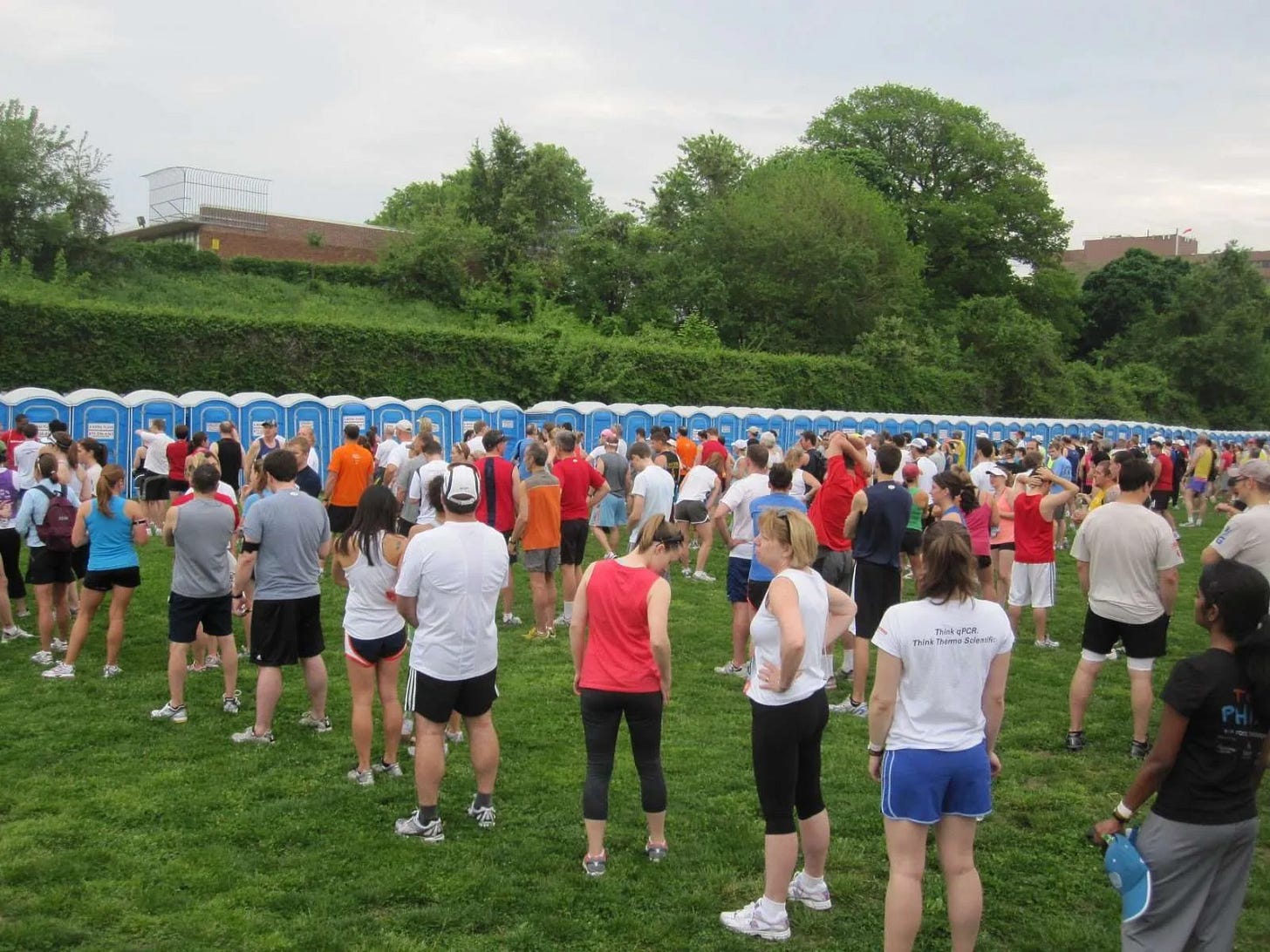Recess #7: Trying to Get a "Head" Start
Fixing modern marathon start line bathroom chaos with simplified math
If you (like me) have ever dropped off a runner at the start of a marathon or race of any notable size (i.e. greater than 50 people), you’ve seen a familiar sight. 10 minutes before the start of the race, runners either shivering from the cold or sweating from the heat stressed out of their mind standing in long lines waiting to go to the bathroom one last time before race start. Almost always, these lines stretch out from portable toilets (porta-potties, porta-john, porta-loo, etc.) rented by event organizers, and somehow it does seem like most racers actually make it through the line in time for their start— or at least you don’t see many runners with toilet paper streaming behind them.
Every time I see this fascinating ritual unfold, I think to myself: “There has to be a way to fix this problem. How many porta-potties does it actually take to properly serve an event like a major race?” Fortunately, the great news is that we can make up math to actually figure this out, and even more importantly, we can figure out how much it actually costs to procure the ideal portable toilet quantity for a race. It will be extremely fun to estimate what percentage of a race entry fee goes towards chemical toilets, and we’ll use the upcoming Boston Marathon as a benchmark to see how close our estimations get to reality.

Before we start to create an equation and figure out the relationships that govern it, we need to figure out the factors that influence required porta-potty quantity, both independent and dependent. Specifically for a marathon or other race-type event, we’re really dealing with a short discrete time period, which might affect these factors. Other events with rental toilets like music festivals or construction sites will almost certainly have different inputs and governing equations including replacement rate, alcohol and food consumption on-site, but specifically for a race, I think the key factors boil down to:
Logistical Factors
Number of racers: N. The number of people running.
Number of start-line spectators: S. How many people are at the start line, but aren’t racing? These people (sometimes me) can cause porta-potty delays for runners, typically yielding high levels of chagrin. Typically a multiple of N from 1-3 depending on the race type and specific rules.
Average loiter start time: T. What is the average arrival time of a runner?
Race start time: R. When the race starts. The longer the duration between T and R, the higher the quantity of toilets required.
Biological Factors
Panic factor: P. Also known as the “rush on the bank” factor, this is an indicator of runner fear they won’t be able to use a bathroom, leading to everyone going at once or multiple times while waiting. Related to race distance and time to start. A variable between 1.0 to 2.0.
Average bladder strength: B. Leading up to a race, what is the amount of time between bathroom trips for a runner.
Average time in bathroom: X. How long is the average person spending in the bathroom?
In reality, I think there is likely a negative quadratic (i.e. upside down parabolic) curve that dictates the total number of people trying to use the bathroom at each moment leading up to a race that peaks maybe 15 minutes before race start (related to the panic factor note above). However, for the sake of brevity I’m focusing on the total throughput of people using the bathroom between drop-off/loiter start and the race start itself. I’m assuming people distribute their pre-race pit stop evenly, which is almost certainly not the case in real life (unfortunately). Regardless, we have the following high-level equation for the amount of toilets needed on site:
The denominator on the right side of this equation is simple to calculate— it’s just the Race Start Time (R) minus the Average Loiter Start Time (T). The numerator is slightly more complicated. In a simple form, it’s just average bathroom trip duration (X) times the number of total trips to the bathroom. The number of bathroom trips, in turn, is dictated by the number of total racers (N) and the number of times they will need to go at the start line, which is actually the Average Loiter Time divided by average bladder strength (B). Our confounding variables, the Panic Factor (P) and Spectator constant (S), are both dimensionless constants at the front of this equation:
As you may notice, the average loiter time actually cancels out in both the numerator and the denominator, which implies that the actual duration that people are on-site is irrelevant, which is the result of out simplification of the problem by ignoring the time-dependent aspects of throughput closer to race start. Part of this simplification also assumes that runners are able to go to the bathroom at any point before arriving at the start line, which might not be the case for many major races such as the Boston Marathon where you take shuttles from downtown. Regardless, the good news is that our simple estimation tool has become even simpler!
Effectively, this boils down the number of porta-potties required for a race to: the number of runners times the the time/trip divided by the time between trips. I’ll admit, even I have had a hard time wrapping my head around the unit logic for this equation, but I believe it’s correct, and thinking about a couple concrete examples while ignoring the confounding variables is helpful. If we have 1,000 runners, and each one goes to the bathroom every minute for one minute at a time, then we always need 1,000 toilets— which the equation correctly shows (again, no matter how long the duration they are at the start line is). Conversely, if we have 600 runners, and each of them needs to use the bathroom once every 60 minutes for one minute, basic logic would suggest we need 10 toilets, and the math bears this out.

If we apply this math to a “major” concrete race example, we can take a look at the upcoming Boston Marathon. In total, there will be 30,000 runners (N) at the 2025 race, which is somewhat of a staggering figure. Average bladder strength is normal so let’s assume every participant needs to use the bathroom once every 45 minutes leading into a well-hydrated rate, and duration in the bathroom is also normal (on average), so should be ~ 1 minute. Panic factor is high because of the chaos and importance of the event and the race duration, so is up at 2.0, similar to a music festival right before a headliner. The start line drop-off is tightly regulated, so it’s likely safe to estimate S factor is close to one. Our simplifications mean that loiter time is not needed for calculations, but for reference most participants start ~ 10am, and based on the bus schedule, most will arrive at an average of ~9am— a full hour before the race.
Plugging all of this into the equations yields:
For the Boston Marathon to run a baseline of smoothness and ensure that lines for porta-potties are minimized, they should need ~thirteen hundred individual units (unless people become desperate). Even this proposed figure of 1,300 porta potties feels low for a crowd of 30,000 people, but GBH reported that the 2024 edition of the Boston marathon had only 700 toilets at the start line! Of course, race start and drop-off times are spread out by ~1 hour total, but I find it difficult to believe that 700 toilets could service that large a crowd, especially when the rush right before the races starts. Either our confounding factor variables such as the Panic Factor need to be toned down, or people at this year’s Boston Marathon will be stressfully lining up to go the bathroom when they should be heading to the start line. (If anyone has first-hand info about the situation at the start line for Boston, please feel free to share).
In any case, it seems the outputs from the calculator can be believed, even if they over estimate the required number. This opens up a ton of (probably very funny) edge-case questions we can attempt to answer as well, like what race in the world has the most toilets, and how many runners could start a marathon on time with just one porta-potty? In the interest of time, though, I will leave these calculations up to the reader (have fun!), because I do want to estimate how much all of these start line toilets cost!
According to vendors, the cost to rent a standard porta-potty for a day with no additional trappings like outdoor sinks or ADA compliance has a wide range in Boston. At the extremes, you can find them as cheap as $150/day, and as high as $250 (or more) per day. If we assume that the Boston Marathon is Black Friday for some local Porta-potty vendors, I’m sure we’re seeing some good discounted pricing from the average cost, so let’s call it $175/“head.” With 700 toilets, this puts the bill at a $122,500, which is honestly lower than I expected. Split across 30,000 runners, this equates to just over $4/runner, or just about 1.6% of the $250 entry fee! This yields many questions.
First, would runners be happy to add an additional $4 to their entry fee if it meant doubling the amount of cans at the start line? I think so! Second, is this ratio constant across all major marathons? ChatGPT’s quick analysis suggests that it is, with the NY Marathon entrants seeing ~1.2% of their entry fee go to start line saloons and ~3% for the London marathon. It would be interesting to see this breakdown for other types of races or events as well. Finally, and perhaps most importantly, how is the porta-potty business so good? It seems like one of those meme-ified DIY businesses like owning vending machines, or a classic PE takeover target like a laundromat chain.
I think we need some real due diligence on this industry in the future… but that’s for another day.
There’s the bell!






Love the analysis. I would love a comparison to triathlon, where I would think competitors are more likely to relieve themselves in the first part of the event.